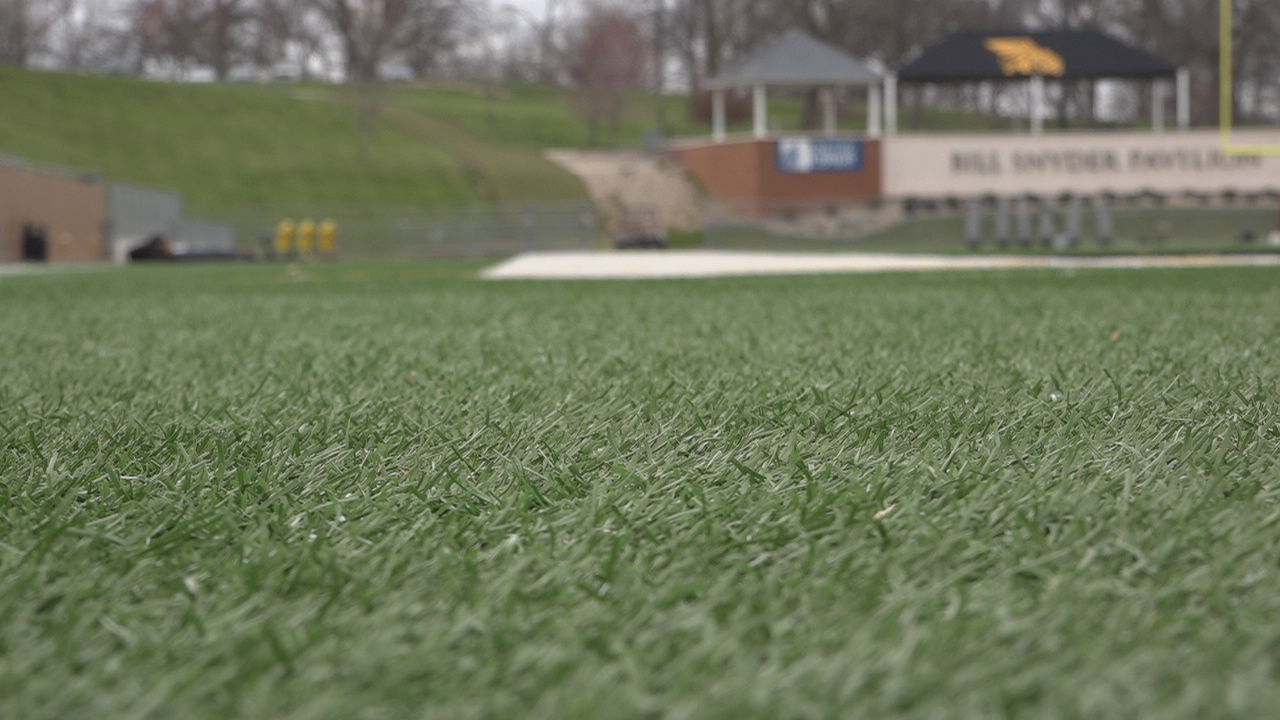Leveling the playing field: SJSD hopes to upgrade to turf

By Riley Funk
If a $20 million bond issue passes Tuesday, grass may be greener for local student-athletes — artificially.
Voters have the opportunity to bring artificial turf fields to Benton, Central and Lafayette high schools as part of a bond issue on the ballot on Tuesday, April 2.
Dave Lau, athletic director at Central High School, said upgrading the fields would be a huge benefit to area athletes. Taking the surfaces from grass to turf would improve playability, bring competitive balance and increase player safety, he said.
“We are at a competitive disadvantage when competing in the greater Kansas City area,” where artificial surfaces are common, Lau said. “It also opens the door to possible increased injury for our athletes because they do not have the opportunity to practice daily on turf,” Lau said.
Grass versus artificial turf has been the subject of debate in football for years. A core issue involves the safety of the surfaces.
In the NFL, injuries to players on turf fields have been cited by critics, with an incident involving Aaron Rodgers, who tore his Achilles tendon in week one of the 2023 NFL season, being much highlighted. The New York Jets starting quarterback sustained the injury while playing on the artificial turf at MetLife Stadium.
But the question remains, is there any steam behind turf grass leading to more injuries?
The answer at the professional level would support that claim, according to studies.
A study by the American Orthopedic Society found more than 4,800 NFL foot and leg injuries occurred during regular season games from 2012-2016. The stats show that 16% more injuries happened per play on artificial turf compared to grass.
These same researchers concluded that if all NFL games had been played on grass, there would have been 319 fewer foot and leg injuries.
The study also found that non-contact injuries on turf surfaces came with a higher risk, with 20% more injuries per play.
But for high school athletes in St. Joseph, turf could actually be safer, experts said.
Grass fields can develop several issues. Games later in the season can be played on harder surfaces, making tackles hurt more.
“You hit a harder surface when it comes down, it’s definitely going to feel a little worse on the body in the joints than if you hit something softer, even if it was a turf field that was softer ground than the hard ground you’re playing on,” said Kevin Luke with SERC Physical Therapy.
Fred Shonkwiler of Spine and Sport Physical Therapy points to another issue involving the wear and tear on grass, which is harder to upkeep.
“If you’ve got a grass field that’s got potholes and divots, then the grass becomes a hazard just as much as the stiffness of the turf,” he said.
From the high school perspective, Lau said it’s hard to have a perfect grass field even with the maintenance department putting in countless hours of work.
“The average maintenance cost of grass can hit estimates of $50,000 a year,” Lau said. “The biggest issue with natural grass fields is its durability. We try to limit the use of our football field to games only. The problem is that we have three football teams, two semi-pro teams and our marching band that use our field. Maintaining a quality surface is nearly impossible.”
Whether the surface is grass or turf, the experts say the best way to prevent injuries comes in training and preparation before athletes hit the field.
“When most athletes in high school get injured, it’s not turf-related. It’s more body-related weaknesses, flexibility issues,” Shonkwiler said.
Luke agrees with Shonkwiler that high school athletes tend to receive injuries due to a lack of preparation. He said the athlete having control of body movements is the best way to stay on the field.
“The ability to slow is much more important than the ability to take off … Your muscles are kind of your brakes of the body, whereas your ligaments, tendons, things like that are more the emergency brake,” Luke said. “When those emergency brakes have to take over and you put a lot of stress on those ligaments, that’s when people tend to get in trouble because they don’t have that muscle control to slow themselves down correctly and to make sure that they are all loosened up and ready to go.”
Doing active warm-ups and dynamic stretches will get the muscles warmed up before competition, Luke said.
Turf or grass, in the end, most football players accept injuries are part of the game.
“We can do as much as we can, but I don’t know if we’ll ever have full safety,” Luke said. “Games that are as violent as like a football or rugby or even soccer sometimes can even be pretty violent with how the movements on the field go.”



